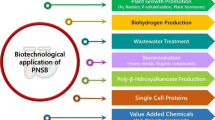Abstract
Tributyl phosphate (TBP) is widely used in nuclear fuel processing and other waste generating chemical industries. Although TBP is bacteriostatic, some microbes are resistant to it and may degrade it. Under dark aerobiosis, purple non-sulfur photosynthetic bacteria degraded up to 0.6 mM TBP, initially present at 2 mm, within 3 weeks and under photosynthetic conditions, Rhodopseudomonas palustris degraded 1.6 mM TBP within 3 weeks. The curing of the Rhodopseudomonas palustris endogenous plasmid demonstrated that the genes involved in the TBP degradation are chromosomal.
Similar content being viewed by others
References
C Berne B Montjarret Y Guountti D Garcia (2004) ArticleTitleTributyl phosphate degradation by Serratia odorifera Biotechnol. Lett. 26 681–686 Occurrence Handle10.1023/B:BILE.0000023030.69207.c0 Occurrence Handle1:CAS:528:DC%2BD2cXivVGgurc%3D Occurrence Handle15200181
HW Boyer D Roulland-Dussoix (1969) ArticleTitleA complementation analysis of the restriction and modification of DNA in Escherichia coli J. Mol. Biol. 41 459–472 Occurrence Handle10.1016/0022-2836(69)90288-5 Occurrence Handle1:CAS:528:DyaF1MXktF2kt7w%3D Occurrence Handle4896022
JM Eraso S Kaplan (1994) ArticleTitleprrA, a putative response regulator involved in oxygen regulation of photosynthesis gene expression in Rhodobacter sphaeroides J. Bacteriol. 176 32–43 Occurrence Handle1:CAS:528:DyaK2cXht1Knu7Y%3D Occurrence Handle8282708
CE Healy PC Beyrouty BR Broxup (1995) ArticleTitleAcute and subchronic neurotoxicity studies with tri-N-butyl phosphate in adult Sprague–Dawley rats Am. Ind. Hyg. Assoc. J. 56 349–55 Occurrence Handle1:CAS:528:DyaK2MXlslGjsL8%3D Occurrence Handle7726100
M Inui JH Roh K Zahn H Yukawa (2000) ArticleTitleSequence analysis of the cryptic plasmid pMG101 from Rhodopseudomonas palustris and construction of stable cloning vectors Appl. Environ. Microbiol. 66 54–63 Occurrence Handle1:CAS:528:DC%2BD3cXktlSgtQ%3D%3D Occurrence Handle10618203
S Kumar KG Mukerji R Lal (1996) ArticleTitleMolecular aspects of pesticide degradation by microorganisms Crit. Rev. Microbiol. 22 1–26 Occurrence Handle1:CAS:528:DyaK28XislGgsLs%3D Occurrence Handle8729958
FW Larimer P Chain L Hauser J Lamerdin S Malfatti L Do ML Land DA Pelletier JT Beatty AS Lang FR Tabita JL Gibson TE Hanson C Bobst JL Torres C Peres FH Harrison J Gibson CS Harwood (2004) ArticleTitleComplete genome sequence of the metabolically versatile photosynthetic bacterium Rhodopseudomonas palustris Nat. Biotechnol. 22 55–61 Occurrence Handle10.1038/nbt923 Occurrence Handle1:CAS:528:DC%2BD2cXls1eg Occurrence Handle14704707
McDonald AR, Odin M, Choudhury H (2002) Chronic risk assessment for tributyl phosphate (CAS NO. 126-73-8). In: Society of Toxicology Meeting, Nashville, TN, March 18–21
K Michel C Brinkmann S Hahn W Dott A Eisentraeger (2004) ArticleTitleAcute toxicity investigations of ester-based lubricants by using biotests with algae and bacteria Environ Toxicol. 19 445–448 Occurrence Handle10.1002/tox.20032 Occurrence Handle1:CAS:528:DC%2BD2cXms1eit7s%3D Occurrence Handle15269923
Nakamura A (1991) International Programme on Chemical Safety – Environmental Health Critiria 112 – Tri-n-Butyl Phosphate. World Health Organisation, Geneva, Switzerland
FM Raushel (2002) ArticleTitleBacterial detoxification of organophosphate nerve agents Curr. Opin. Microbiol. 5 288–295 Occurrence Handle10.1016/S1369-5274(02)00314-4 Occurrence Handle1:CAS:528:DC%2BD38XktFynsLk%3D Occurrence Handle12057683
A Suwanto S Kaplan (1992) ArticleTitleA self-transmissible, narrow-host-range endogenous plasmid of Rhodobacter sphaeroides 2.4.1: physical structure, incompatibility determinants, origin of replication, and transfer functions J. Bacteriol. 174 1124–1134 Occurrence Handle1:CAS:528:DyaK38Xht1alsrc%3D Occurrence Handle1735707
RAP Thomas A Greated K Lawlor M Bailey LE Macaskie (1997a) ArticleTitleStabilisation of Tributyl phosphate-biodegradative ability of natural-occuring Pseudomonas using ampicillin Biotechnol. Technol. 11 781–785 Occurrence Handle10.1023/A:1018464906236 Occurrence Handle1:CAS:528:DyaK2sXns1ylu74%3D
RAP Thomas AP Morby LE Macaskie (1997b) ArticleTitleThe biodegradation of tributyl phosphate by naturally occurring microbial isolates FEMS Microbiol. Lett. 155 155–159 Occurrence Handle10.1016/S0378-1097(97)00381-9 Occurrence Handle1:CAS:528:DyaK2sXmsVKltbg%3D
Author information
Authors and Affiliations
Corresponding author
Rights and permissions
About this article
Cite this article
Berne, C., Allainmat, B. & Garcia, D. Tributyl phosphate degradation by Rhodopseudomonas palustris and other photosynthetic bacteria. Biotechnol Lett 27, 561–566 (2005). https://doi.org/10.1007/s10529-005-2882-7
Received:
Revised:
Accepted:
Issue Date:
DOI: https://doi.org/10.1007/s10529-005-2882-7




